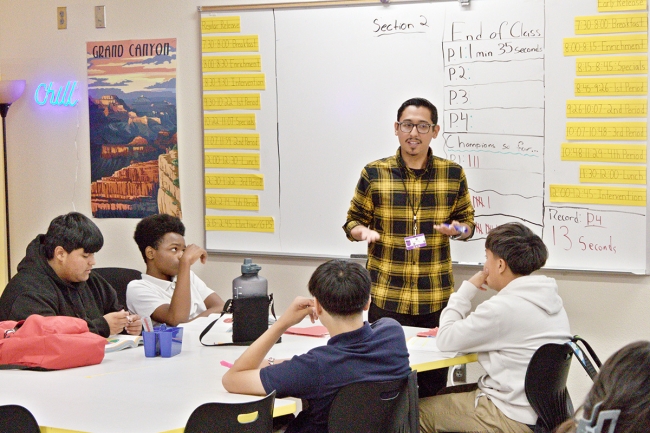You have /5 articles left.
Sign up for a free account or log in.

The Arizona Teacher Residency program, which launched in 2022, is part of a growing cohort of programs aimed at growing the pipeline of K-12 educators.
Arizona Teacher Residency/Northern Arizona University
A fast-growing collection of teacher-preparation programs designed to recruit and retain more educators—including apprenticeships, residencies and other scholarships—are sprouting up to help fill the nation’s teacher-vacancy hole, which has more than tripled in size since 2010.
That void exists in part because the new teacher pipeline dried up in the wake of the Great Recession, which spurred national conversations about ballooning student debt and worries that the cost of earning a degree in some fields, including teaching, isn’t worth the relatively low-paying career prospects. Between 2010 and 2021, enrollment in traditional teacher-preparation programs dropped 45 percent, according to a report the American Association of Colleges for Teacher Education (AACTE) published earlier this year.
But the long decline that followed the 2008 recession may be on the rebound: Enrollment in and completion of teacher preparation programs increased by 3 percent between the 2019–20 and 2020–21 school years, which is the latest data available.
“We don’t yet know if that’s statistical noise or if this is maybe the beginning of a turnaround,” said Jaci King, research, policy and advocacy consultant, for the AACTE. “What we do know is that there’s been a huge amount of work going on to make educator-preparation programs more accessible to a broader array of students.”
Under a directive from President Biden, the Labor Department has ramped up its investment in stemming the teacher shortage over the past two years, giving more than $100 million in apprenticeship grants to state and local initiatives that partner with higher learning institutions and other nonprofits to mitigate the financial burden of becoming a teacher.
Between 2018 and 2023, the number of federally registered teacher-apprenticeship programs increased by 247 percent, to 7,450, according to the DOL. They support an “earn-while-you-learn” model that allows aspiring teachers—including paraprofessionals already employed by a school district—to get paid to work in classrooms under the supervision of a mentor while simultaneously earning a teaching degree or credential, at low or no cost.
“The idea is to both lower the financial barrier and expand the amount of clinical preparation,” King said, adding that such initiatives also aim to diversify the overwhelmingly white teacher workforce, which serves the country’s increasingly racially diverse student population. “It’s not the traditional one semester or less of student teaching that is almost always unpaid and presents a huge financial challenge for a lot of students, because if you’re student teaching all day and going to school, it’s very hard to have a paid job.”
‘Education Is Meeting the Workforce’
Like apprenticeships, teacher-residency programs offer an alternative pathway to becoming an educator and have grown especially popular among people looking to make a career change.
The residencies pair coursework with lengthy, intensive clinical training from a seasoned classroom mentor. Unlike apprenticeships, however, pay and other financial assistance for resident teachers can vary. And such programs have historically offered people with a bachelor’s degree in another field a low-cost option for earning a master’s degree in teaching.
Although teacher-residency models have been in operation for more than two decades, the number of programs has increased by 88 percent since 2020, according to the National Center for Teacher Residencies (NCTR); during the 2023–24 school year, 77 teacher-residency programs across 26 states and the District of Columbia operated under the NCTR.
“Residencies are where education is meeting the workforce,” said Kathlene Campbell, CEO of the NCTR. “Gone are the days where you only learn theory and later on practice it. A residency brings both of those things together so you’re learning about the content while also in a classroom with children and an experienced teacher who’s helping you make those instructional decisions in order to propel children’s academic achievement.”
In exchange for tuition remission, stipends and other financial support, graduates of resident-teacher programs typically promise to work in a local school district—often in a high-need school—for a certain number of years after they become fully credentialed.
Retention Matters, Too
Graduates who break that contract and leave their teaching job early have to pay back the money they received. That financial incentive to stay, combined with the extra support teacher residents get, has proven to be a successful model for retention as well as training. Studies show that inadequate preparation not only leads to worse outcomes for students but also remains one of the factors pushing more than 44 percent of new teachers to leave the classroom within five years.
“If you know you’re more effective and feel more prepared to teach students, you’re going to stay in the field longer,” said Campbell, adding that the vast majority of principals report that residency program graduates are more effective teachers than those who come through other pathways.
According to the NCTR, 78 percent of the some 9,000 cumulative graduates of teacher residencies return to the classroom for a third year. And data also shows that when an educator makes it past the first few years of teaching, they’re more likely to stay in the field for the long term.
The Boston Teacher Residency, one of the oldest residency programs in the country, launched in the early 2000s and exemplifies the long-term success that teacher residencies can have on building a pipeline of educators that reflects the diversity of the students they serve.
Half of the 762 total graduates of the program over the last 21 years were people of color, according to Jesse Solomon, executive director of Boston Plan for Excellence, which runs the BTR. And the job-retention rate for BTR teachers is about 20 percent higher than for teachers in the district who graduated from other preparation programs.
About 80 percent of BTR graduates were still teaching—many in high-need subjects like math, multilingual education and special education—after three years; 68 percent remained in the classroom after five years.
“Twenty years in, many of those people are not only teachers and teacher leaders, they’re also principals and superintendents in the district,” Solomon said. “That’s powerful both in terms of what it does for kids, but also professionally—they hire each other, coach each other and help each other develop.”
Financing Teacher Prep
Such outcomes are the goal of the Arizona Teacher Residency, which launched at Northern Arizona University in 2022 to help ease what the state’s education department called “a dire shortage of teachers.”
The average teacher in the Grand Canyon State earns about 33 percent less than other college-educated workers, and they teach in classrooms that receive the second-lowest per-pupil spending allocation in the country. As a result of decades-long disinvestment in public education, nearly 30 percent of teacher vacancies were unfilled more than a month into the 2023–24 school year, according to a report from the Arizona Personnel Administrators Association.
Many of those positions have been vacated by frustrated early-career teachers, which is where the Arizona Teacher Residency’s mentoring and early-career support comes in. “We’re preventing that hemorrhaging when teachers are the most vulnerable to burning out,” Victoria Theisen-Homer, founding director of program, said. “Once we get them past the first few years, they’re much more likely to stay.”
The program was started with a one-time $5 million federal grant from the pandemic-era Elementary and Secondary School Emergency Relief (ESSER) Fund. It’s still relatively small, with about 20 teachers in training in each of the first three cohorts, who have all agreed to teach in a Title I school for a minimum three years after completing their coursework.
Though the original ESSER grant is set to expire in September, the residency has since diversified its funding streams to include other grants, philanthropic support and backing from a much larger state-funded program called the Arizona Teachers Academy (ATA), which pays tuition for the dozens of students enrolled in the Arizona Teacher Residency, as well as hundreds of other aspiring teachers in the state.
The ATA, which the state approved in 2017, waives tuition for students at Arizona’s universities and community colleges who are pursuing a teaching degree as long as they agree to teach in a local school after graduation for the same number of years they received support for their degree.
State support from the ATA is “critical” to sustaining and expanding the teacher residency program at NAU, Theisen-Homer said. However, it is far from clear that lawmakers will continue to invest in it.
Though the ATA started as an unfunded legislative mandate, it got $15 million from the state’s general fund in 2020. The following year, it got $15 million—plus $6 million in federal pandemic relief money and an additional one-time $15 million from the state’s medical marijuana fund. Last year, the state appropriated $30 million of general fund money toward the program.
All that extra investment has allowed the teachers’ academy to scale up. Between the 2018–19 and 2022–23 academic years, enrollment in the ATA increased from 479 to 3,255 students, according to a report from the Arizona Board of Regents; last year, more than 900 students completed the program.
Andi Fourlis, superintendent of Mesa Public Schools, said the investment in the ATA has had a “significant impact on building a pipeline and helping to close the teacher-shortage gap.” This time last year, her district had 140 teacher vacancies, compared to 80 this July. “This is the first time we’ve put significant dollars toward plugging the [teacher shortage] hole and building that pipeline.”
But the teachers’ academy momentum is in jeopardy of slowing. Facing a $1.4 billion budget shortfall—driven largely by the state’s $332 million private school voucher program—the Arizona Legislature cut the ATA’s budget in half, to $16 million, for fiscal year 2025.
That funding reduction “is likely to affect both our new enrollment numbers and our retention numbers,” Carole Basile, dean of the college of education at Arizona State University, said in an email.
And the result of fewer well-prepared teachers entering the profession—in Arizona and elsewhere—is a widening student-achievement gap, said Linda Darling-Hammond, president and CEO of the Learning Policy Institute.
“When we have shortages, we hire people who don’t have training to teach. They’re less effective, they’re usually assigned to students with the greatest needs and they leave at higher rates,” she said. “We create this problem by the way we manage the teaching profession.”
But when new teachers have had high-quality preparation, such as through a teacher residency or apprenticeship program, she said, “it gives them a running start, which then also contributes to them being able to stay.”








